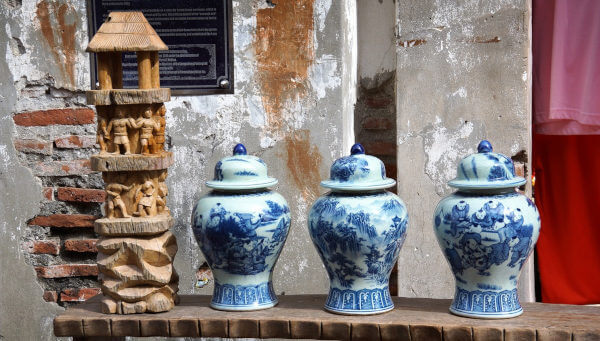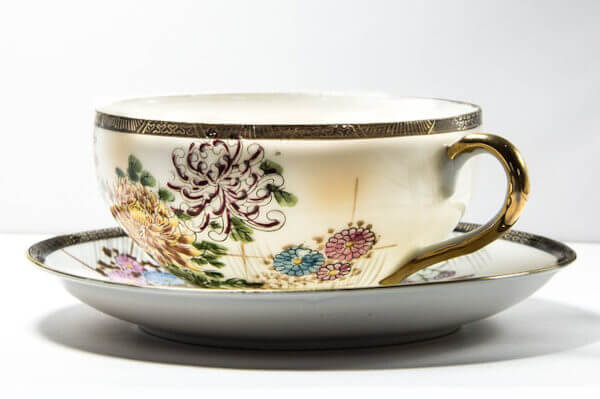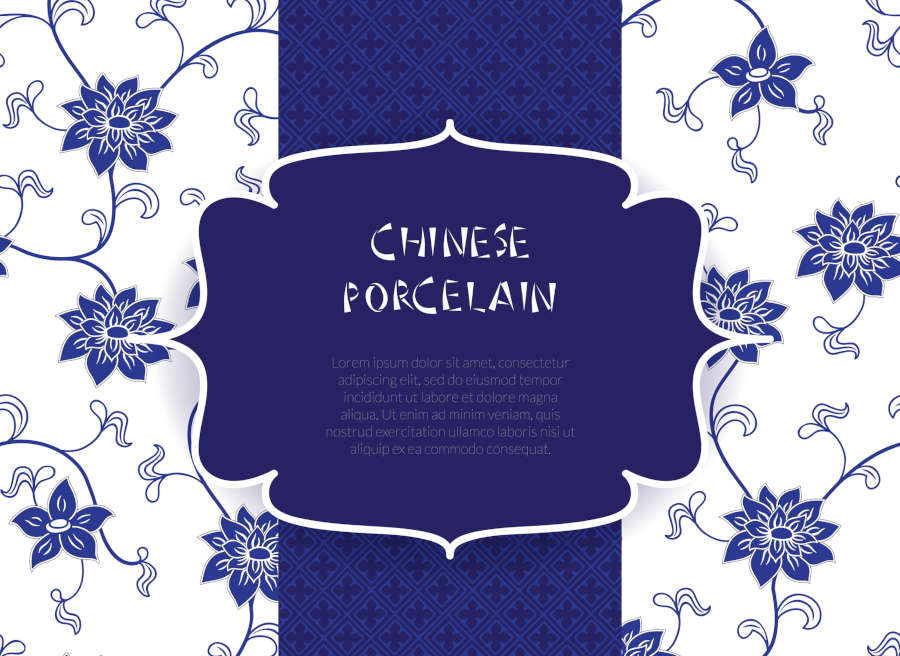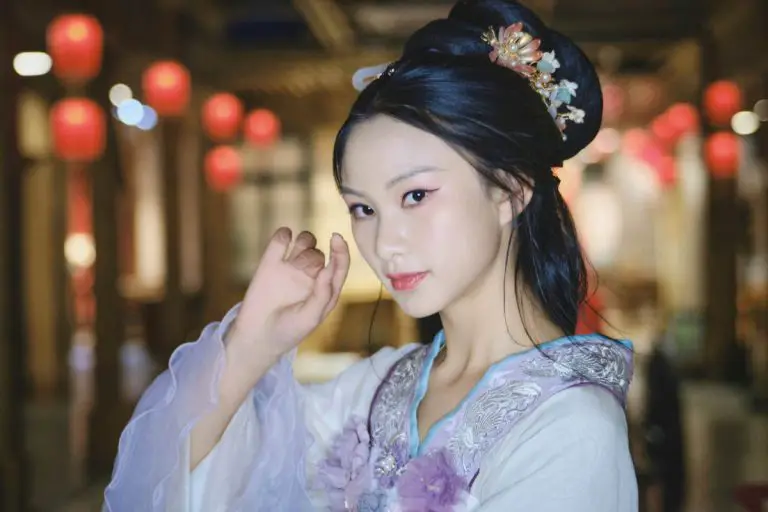Chinese porcelain is one of the most unique products in the history of Chinese culture.
Unlike porcelain equipment, tools, and ornaments we see in western countries, Chinese porcelains have unique translucency and luster, giving Chinese earthenware rather unique characteristics and popularity over those from other countries.
In this post, we will learn all you need to know about Chinese porcelains: their history, the different types available, identifications between different types, and more.
Without further ado, let us begin.
Brief History of Chinese Porcelain
Just like the Chinese jade (one of, if not the most important material in Chinese culture), Chinese porcelains also have a very long history throughout the whole of Chinese history.
Neolithic Age
Various discoveries have shown us how porcelain earthenware in China has existed since the Neolithic Age, with one of the oldest findings being the earthenware excavations believed to have originated from the Yangshao Culture period. Many of the porcelain findings from this period came with either white or red colors in their designs.
There are also black porcelain findings believed to have originated from the Longshan Culture period where black equipment, tools, and ornaments are very common during the period.
Eastern Han Dynasty (25-220 AD)
Many experts think that the earthenware excavations from the Neolithic period cannot be considered true Chinese porcelains, but rather as proto-porcelains due to their simplicity in shapes and designs. Many think that true Chinese porcelains have only been invented during the Eastern Han period, although it’s still a topic for ongoing debates today.
Nevertheless, the porcelain earthenware findings from this period often involve green color schemes in their designs.
Based on the patterns and design styles, these findings are believed to have originated from the Shangyu area, Zhejiang province, south of the Yangtze River. Chinese porcelains from this period are very durable and long-lasting, with many of these findings still having their very bright colors with beautiful translucency.
Three Kingdoms, Jin Dynasty, and Sui Dynasty (221-618 CE)
Throughout this period, porcelain designs, patterns, and shapes didn’t change much compared to the Eastern Han period.
The fall of the Han Dynasty brought a period of power struggle in China, so this period is one of turmoil and wars. However, the production of Chinese porcelain significantly increased during this period, which also translates into the widespread use of porcelain tools and equipment.
During this period, jade green (celadon) porcelain became one of the most popular designs, widely used all over China. Shangyu, located south of the Yangtze River, also became the center of celadon porcelain production during this era.
However, further to the north, the porcelain earthenware produced has different designs and colors and tends to have more diverse and translucent colors. The Henan and Hebei provinces were the centers of porcelain production in Northern China.
See some beautiful Chinese Porcelain Vase & Tableware – Aff.link

Tang Dynasty (618-907 CE)
During the Tang dynasty period, porcelain had a much higher value not only in China but in other countries.
The silk road connected China and the Far East with the Middle East and Europe, effectively becoming the ‘bridge’ between the East and West, encouraging higher demands for Chinese porcelain from countries outside China. Chinese porcelain became very valuable back then, especially sought after in Middle Eastern countries.
There are two types of porcelain that were really popular in this era. The first was Xing porcelain, which originated from northern China, centered in the city of Lingcheng, Xingtai, and Neiqiu in Hebei province. These three cities are considered the center of production for Xing porcelain, famous for its white color with elegant design and great durability. The overall high quality of Xing porcelain allowed it to become the standard during the Tang Dynasty.
The second popular type of porcelain during this era is the Celadon porcelain, popular for its jade green (celadon) to bluish-green colors. The distinct color scheme provides a unique value for the celadon porcelain, and while westerners loved the white Xing porcelain, Easterners, especially those from Islamic countries, preferred the color of celadon porcelain.
Song Dynasty (960-1279 CE)
Throughout the Song dynasty, both the production and trade of porcelain increased to a whole other level when compared to the Tang dynasty period. Artistic and aesthetic values have become the focus during this period, and so the porcelain earthenware throughout this era has more complex, unique, and beautiful shapes, patterns, and designs. It is also the Song Dynasty that established porcelain making as a national industry.
Various industries in China also developed significantly as a whole during the Song Dynasty period, which also contributed to the production of porcelain. New mixtures of materials have been found, allowing the porcelain ware produced during this era to be much more complex and beautiful. Out of all these inventions, the usage of cobalt in finishing porcelain wares is one of the most innovative, allowing porcelain wares with a blue tint, which are still popular even today.
During this period, cobalt porcelain wares along with the still-popular celadon porcelain wares are still heavily exported to the Islamic kingdoms.
Ming Dynasty (1368-1664 CE)
By the time of the Ming dynasty period, Chinese porcelain has evolved to become the magnum opus of Chinese culture with very elegant designs. Various technical innovations also contributed to this. For example, various inventions have allowed porcelain makers of this era to mix manganese (a recently found chemical element back then) with cobalt to prevent bleeding when the porcelain is heated. Manganese can also help prevent color distortion, allowing more exquisite designs, and thus Ming-period porcelain wares are often considered the best of the best, the pinnacle of Chinese culture.
Many of the Ming-period porcelain wares that survived today still have brilliant luster and transparency, so they are extremely expensive.
Related reading: Innovation Through the Ages: Unraveling the Timeline of Chinese Inventions – Opens in new tab
Qing Dynasty (1644-1912 CE)
Although Ming-period porcelain wares are considered better, the Qing Dynasty period has also contributed to the history of Chinese porcelain.
In this era, Chinese porcelain wares were heavily exported to Europe and America, which cemented the reputation of Chinese porcelain as a very valuable work of art. Rich westerners during this era can even order custom-made porcelain wares with unique designs, and many of these custom-made Qing porcelain wares are very expensive today due to their one-of-a-kind designs.
Why Chinese Porcelain Is so Special?
Not only Chinese porcelain, but Chinese ceramics, in general, are famous for their durability. Well-maintained Chinese porcelain, when stored properly, can stay in good condition for more than 1,000 years, as proven by many porcelain wares, especially those from the Ming Dynasty, which are still well-preserved today.
Chinese porcelain’s durability comes from its main material: kaolin, which is a type of clay that contains various minerals that allow the unique shape, color, and durability of porcelain and ceramic.
Chinese porcelain is also created with unique techniques that provide its elegant, unique luster. After the earthenware has been shaped, the porcelain artisan will then add an additional, waterproof layer that is typically made of clay, glassy materials like sand or silica, flux (like feldspar or calcium), and others. This layer should have a lower melting point than the inside layers, while also containing the coloring materials (cobalt, manganese, etc.)
While the composition of different Chinese porcelain wares remains relatively the same, the mixture of materials used by different artisans can vary, creating unique signatures between different artisans.
Check out our “Free Art Library“. We have compiled some great free resources, about Chinese art, for your research.

Different Types of Chinese Porcelains
Throughout the different periods in Ancient China, there have been various different types of Chinese porcelain, and here are some of the notable ones:
Blue and White Porcelain
The most popular type of Chinese porcelain with its unique white and blue color scheme. Very popular all around the world due to its unique elegance and brilliant luster.
This type of Chinese porcelain has been around since the Tang and Song dynasties period but became widely popular during the Ming dynasty period. Ming-period blue and white porcelain is especially famous for its very high quality, and today is still widely regarded as a very valuable commodity all around the world.
Celadon Porcelain
One of the oldest types of Chinese porcelain, famous for its jade green color, just like Chinese jade. This type of porcelain wares is often used in various sacred rituals and ceremonies in Chinese traditions.
To produce its unique celadon (jade green) color, clay is mixed with wood ash and iron before being heated in a low oxygen condition. To achieve this purpose, a special type of kiln is used.
White Porcelain
A very popular type of Chinese porcelain before the invention of white and blue porcelain. The white color used in this type of porcelain can vary, but the most common one is ivory white. Throughout the Tang dynasty period, white porcelain was often exported to western countries through the silk road.
Black Porcelain
A type of Chinese porcelain famous for its distinct color during its time, the black coloration is created by mixing black iron oxide that produces very thick and dense black.
During the Song dynasty period, black Chinese porcelain wares reached the pinnacle of their popularity and were very popular in various different applications. However, its popularity was then replaced by white porcelain, especially after the Ming dynasty period.
See some beautiful Chinese Porcelain Vase & Tableware – Aff.link
How To Evaluate The Age of Chinese Porcelain
While there isn’t a one-size-fits-all method on how to estimate the age of Chinese porcelain, there are some techniques we can use:
Inspecting the Crackles
Although Chinese porcelain is very durable with great longevity, there will always be imperfections, and crackles can be a great indicator of the age of the porcelain ware. The older the crackle is, the more yellow and/or brown color it will be.
Crackles can be made artificially to make an item look older than it is, so a careful inspection of crackles should be conducted.
Discoloration
Another important factor you can inspect to measure the age of the porcelain ware is discoloration.
In general, due to its great durability, discoloration should be relatively minimal, unless the porcelain has been buried under the sea for hundreds of years.
So, if the porcelain is discolored (and has remained on a dry surface), it is a sign of very old porcelain ware.
Rust spots
Over a long period of time, an iron residue that was naturally contained in the clay moves slowly to the surface of the porcelain ware, which will form these rust spots. Rust spots can be large, but typically they are relatively small and black in color. Larger rust spots tend to be lighter (light brown) in color.

Chinese Porcelain FAQ
Why Is Porcelain So Expensive?
Chinese porcelain is now a very expensive commodity due to its long-lasting elegance and beauty.
To make Chinese porcelain, a high level of expertise is needed so the artisan can accurately mix the right materials, shape it into the right shape, and provide the aesthetic finish and design. Also, when compared to other types of earthenware from other countries, Chinese porcelain is much more durable with higher mineral content.
Many Chinese porcelain wares also have unique, very beautiful designs and carvings, and the rarer and more unique the porcelain ware is, the more expensive it will be.
Are Porcelain and Ceramic the Same?
While related, both aren’t one and the same. Both of them have clay as their main composition. However, the porcelain used kaolin (which is considered the purest form of clay). The higher the kaolin contained within the clay used to make porcelain, the higher the quality of the porcelain ware with better durability and more brilliant luster.
Is Porcelain Stronger Than Ceramic?
Yes, structure-wise, porcelain is stronger than ceramic, mainly due to kaolin. Also, mixtures of other substances may be applied after the initial heating, allowing Chinese porcelain to have higher durability than regular ceramic.
Are All Chinese Pottery Marked?
A common misconception is to think that only marked porcelain wares are real, but that isn’t actually the case. Marking is only performed after the Ming dynasty period, which can be an indicator of when the porcelain was made and a factor to consider when evaluating its authenticity. However, not all authentic Chinese porcelain has marks.
See some beautiful Chinese Porcelain Vase & Tableware – Aff.link
An Introduction to Chinese History & Culture (Aff.link)
Dive into China’s rich past and intriguing present! From ancient dynasties to modern powerhouses, uncover Chinese culture facts, pivotal moments, and the captivating tales that have shaped this vast nation.
Feature Image from Depositphotos
Stay in Touch
 Join our newsletter by using the forms on this website or click here!
Join our newsletter by using the forms on this website or click here! Follow us on Google News
Follow us on Google News Follow us on Facebook
Follow us on Facebook






